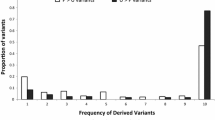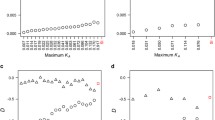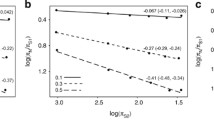Abstract
Synonymous substitution rates in mitochondrial and nuclear genes of Drosophila were compared. To make accurate comparisons, we considered the following: (1) relative synonymous rates, which do not require divergence time estimates, should be used; (2) methods estimating divergence should take into account base composition; (3) only very closely related species should be used to avoid effects of saturation; (4) the heterogeneity of rates should be examined. We modified the methods estimating synonymous substitution numbers to account for base composition bias. By using these methods, we found that mitochondrial genes have 1.7—3.4 times higher synonymous substitution rates than the fastest nuclear genes or 4.5–9.0 times higher rates than the average nuclear genes. The average rate of synonymous transversions was 2.7 (estimated from the melanogaster species subgroup) or 2.9 (estimated from the obscura group) times higher in mitochondrial genes than in nuclear genes. Synonymous transversions in mitochondrial genes occurred at an approximately equivalent rate to those in the fastest nuclear genes. This last result is not consistent with the hypothesis that the difference in turnover rates between mitochondrial and nuclear genomes is the major factor determining higher synonymous substitution rates in mtDNA. We conclude that the difference in synonymous substitution rates is due to a combination of two factors: a higher transitional mutation rate in mtDNA and constraints on nuclear genes due to selection for codon usage.
Similar content being viewed by others
References
Ayala FJ, Chang BSW, Hartl DL (1993) Molecular evolution of the Rh3 gene in Drosophila. Genetica 92:23–32
Ayala FJ, Hartl DL (1993) Molecular drift of the bride of sevenless (boss) gene in Drosophila. Mol Biol Evol 10:1030–1040
Ballard JWO, Kreitman M (1994) Unraveling selection in the mitochondrial genome of Drosophila. Genetics 138:757–772
Ballard JWO, Kreitman M (1995) Is mitochondrial DNA a strictly neutral marker? TREE 10:485–188
Begun DJ, Aquadro CF (1994) Evolutionary inferences from DNA variation at the 6-phosphogluconate dehydrogenase locus in natural populations of Drosophila: selection and geographic differentiation. Genetics 136:155–171
Berry AJ, Ajioka JW, Kreitman M (1991) Lack of polymorphism on the Drosophila fourth chromosome resulting from selection. Genetics 129:1111–1117
Berthier F, Renaud M, Alziari S, Durand R (1986) RNA mapping on Drosophila mitochondrial DNA: precursors and template strands. Nucleic Acids Res 14:4519–4533
Brown WM, Prager EM, Wang A, Wilson AC (1982) Mitochondrial DNA sequences of primates: tempo and mode of evolution. J Mol Evol 18:225–239
Caccone A, Amato GD, Powell JR (1988) Rates and patterns of scnDNA and mtDNA divergence within the Drosophila melanogaster subgroup. Genetics 118:671–683
Clary DO, Wolstenholme DR (1985) The mitochondrial DNA molecule of Drosophila yakuba: nucleotide sequence, gene organization, and genetic code. J Mol Evol 22:252–271
Comeron JM (1995) A method for estimating the numbers of synonymous and nonsynonymous substitutions per site. J Mol Evol 41: 1152–1159
DeSalle R, Freedman T, Prager EM, Wilson AC (1987) Tempo and mode of sequence evolution in mitochondrial DNA of Hawaiian Drosophila. J Mol Evol 26:157–164
FlyBase (1997) FlyBase —A Drosophila database. Nucleic Acids Res 25:63–66 [http://flybase.bio.indiana.edu/]
Gleason JM, Caccone A, Moriyama EN, White KP, Powell JR (1997) Mitochondrial DNA phylogenies for the Drosophila obscura group. Evolution 51:433–440
Hilton H, Kliman RM, Hey J (1994) Using hitchhiking genes to study adaptation and divergence during speciation within the Drosophila melanogaster species complex. Evolution 48:1900–1913
Ina Y (1995) New methods for estimating the numbers of synonymous and nonsynonymous substitutions. J Mol Evol 40:190–226
Ina Y (1997) Pattern of synonymous and nonsynonymous substitutions: an indicator of mechanisms of molecular evolution. J Genet 75:91–115
Kimura M (1980) A simple method for estimating evolutionary rates of base substitutions through comparative studies of nucleotide sequences. J Mol Evol 16:111–120
Li W-H (1993) Unbiased estimation of the rates of synonymous and nonsynonymous substitution. J Mol Evol 36:96–99
Li W-H, Wu C-I, Luo C-C (1985) A new method for estimating synonymous and nonsynonymous rates of nucleotide substitution considering the relative likelihood of nucleotide and codon changes. Mol Biol Evol 2:150–174
Martin AP, Palumbi SR (1993) Body size, metabolic rate, generation time, and the molecular clock. Proc Natl Acad Sci USA 90:4087–4091
Miyata T, Hayashida H, Kikuno R, Hasegawa M, Kobayashi M, Koike K (1982) Molecular clock of silent substitution: at least six-fold preponderance of silent changes in mitochondrial genes over those in nuclear genes. J Mol Evol 19:28–35
Moriyama EN, Gojobori T (1992) Rates of synonymous substitution and base composition of nuclear genes in Drosophila. Genetics 130:855–864
Moriyama EN, Hartl DL (1993) Codon usage bias and base composition of nuclear genes in Drosophila. Genetics 134:847–858
Moriyama EN, Powell JR (in press) Codon usage bias and tRNA abundance in Drosophila. J Mol Evol
Nei M, Gojobori T (1986) Simple methods for estimating the numbers of synonymous and nonsynonymous substitutions. Mol Biol Evol 3:418–426
Pamilo P, Bianchi NO (1993) Evolution of the Zfx and Zfy genes: rates and interdependence between the genes. Mol Biol Evol 10:271–281
Pesole G, Dellisanti G, Preparata G, Saccone C (1995) The importance of base composition in the correct assessment of genetic distance. J Mol Evol 41:1124–1127
Powell JR (1983) Interspecific cytoplasmic gene flow in the absence of nuclear gene flow: evidence from Drosophila. Proc Natl Acad Sci USA 80:492–95
Powell JR, Caccone A, Amato GD, Yoon C (1986) Rates of nucleotide substitution in Drosophila mitochondrial DNA and nuclear DNA are similar. Proc Natl Acad Sci USA 83:9090–9093
Powell JR, Moriyama EN (1997) Evolution of codon usage bias in Drosophila. Proc Natl Acad Sci USA 94:7784–7790
Rand DM (1994) Thermal habit, metabolic rate and the evolution of mitochondrial DNA. TREE 9:125–131
Rand DM, Dorfsman M, Kann LM (1994) Neutral and non-neutral evolution of Drosophila mitochondrial DNA. Genetics 138:741–756
Rand DM, Kann LM (1996) Excess amino acid polymorphism in mitochondrial DNA: contrasts among genes from Drosophila, mice, and humans. Mol Biol Evol 13:735–748
Satta Y, Ishiwa H, Chigusa SI (1987) Analysis of nucleotide substitutions of mitochondrial DNAs in Drosophila melanogaster and its sibling species. Mol Biol Evol 4:638–650
Sharp PM, Li W-H (1989) On the rate of DNA sequence evolution in Drosophila. J Mol Evol 28:398–402
Shields DC, Sharp PM, Higgins DG, Wright F (1988) “Silent” sites in Drosophila genes are not neutral: evidence of selection among synonymous codons. Mol Biol Evol 5:704–716
Simmons GM, Kwok W, Matulonis P, Venkatesh T (1994) Polymorphism and divergence at the prune locus in Drosophila melanogaster and D. simulons. Mol Biol Evol 11:666–671
Solignac M, Monnerot M, Mounolou J-C (1986) Mitochondrial DNA evolution in the melanogaster species subgroup of Drosophila. J Mol Evol 23:31–40
Tamura K (1992a) Estimation of the number of nucleotide substitutions when there are strong transition-transversion and G + C-content biases. Mol Biol Evol 9:678–687
Tamura K (1992b) The rate and pattern of nucleotide substitution in Drosophila mitochondrial DNA. Mol Biol Evol 9:814–825
Tamura K, Nei M (1993) Estimation of the number of nucleotide substitutions in the control region of mitochondrial DNA in humans and chimpanzees. Mol Biol Evol 10:512–526
Wells RS (1995) Nucleotide variation at the Gpdh locus in the genus Drosophila. Genetics 143:375–384
Author information
Authors and Affiliations
Rights and permissions
About this article
Cite this article
Moriyama, E.N., Powell, J.R. Synonymous substitution rates in Drosophila: Mitochondrial versus nuclear genes. J Mol Evol 45, 378–391 (1997). https://doi.org/10.1007/PL00006243
Received:
Accepted:
Issue Date:
DOI: https://doi.org/10.1007/PL00006243




